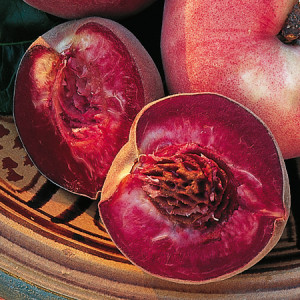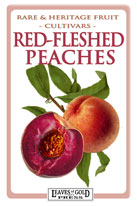Red-fleshed Peaches (Prunus persica)
Red-fleshed peaches are also known as Vineyard Peaches, Pêches de Vigne (France), Blackboy Peaches (New Zealand), Indian Blood Peaches (USA), Blood Peaches, or even Pleaches, a plum/peach hybrid – (see below).
Red-fleshed peaches are far rarer than the white-fleshed or yellow-fleshed types. In some countries they are almost impossible to find. How they spread from China to other parts of the world is an interesting story, shrouded in mystery.
Their colour sets these fruits apart — the deep ruby shade of their flesh make them spectacular additions to recipes. Their flavour, too, is unique. Moreover, red-fleshed peaches have numerous health benefits. Rich in antioxidant anthocyanins and flavonoids, they possess qualities that both heal and protect the human body.
The Unique Miracle of Fruit Forest Peaches
Australia’s Mornington Peninsula in Victoria is ideally located for peach growing, at 37.8° south of the equator. Famous for its apple orchards, cherry orchards, strawberry farms and vineyards, the “MornPen” has many sites with the perfect conditions for stone-fruit growing. Its maritime influence contributes to its unique ‘‘terroir’ (pronounced “terr-wahr”).
Within the low, rolling hills of the Peninsula there is considerable diversity of climate, soil types, rainfall and altitude as well as the usual variations in topography, which give each vineyard and orchard site its unique characteristics.
In particular the Red Hill Ward with its rich, red soils, grows excellent peaches. This fertile soil developed on tertiary basalts from ancient volcanic lava flows. Millions of years ago, this entire landscape was aflame with volcanos spewing mineral-rich material from beneath the earth’s crust. Over the millennia, wind and rain eroded this material into the vibrant, red fruit-growing soils we know today.
In this unique location one estate in particular specialises in growing red-fleshed peaches. The Fruit Forest is situated on the Peninsula’s eastern side in a well-watered valley with gentle, north-facing slopes. In late summer (February) the long-awaited red-fleshed peaches ripen at last, for a fleeting season of about a fortnight. They are snapped up by friends, family and eager customers at local farmgates, greengrocers, and restaurants.
We grow the genuine red-fleshed Pêche de Vigne fruits, as well as the plum/peach hybrid “pleaches” (sold as “Blackboy” by some Australian nurseries).
Pêche de Vigne
A favorite late summer treat in France is the Pêche de Vigne. This term translates literally as ‘Peach of the Vine’, but it can also be translated as ‘Peach of the Grapevine’ or ‘Vineyard Peach’. Pêche de Vigne is not a variety but rather a type of peach with many varieties of its own. It flowers late, and its fruits ripen late. Some of the Pêche de Vigne varieties have white flesh or yellow flesh, but many are different from other peaches in that their flesh is red.
(Somewhat bewilderingly the French also use the term ‘Pêche de Vigne’ to describe the fruit from trees whose shape is ‘en plein-vent’ ‘exposed to the wind’ — that is, trees that are free-growing and have not been espaliered.)
Pêche de Vigne trees traditionally play an important role in French wine production, particularly in the south, and their fruits are so highly regarded that an annual festival is held in their honour.
In France’s Bordeaux region, the official source of Bordeaux wines, the vignerons (wine-grape growers) plant roses at the head of every row of grapevines. The roses look beautiful in bloom, however their purpose is not to be ornamental, but to be useful. Being susceptible to mildew, they will show signs of a mildew attack before the grape vines do, thus enabling the vignerons to start treating the vines while the disease is still in its early stages. This gives a better outcome.
Due to the fact that Pêche de Vigne fruits ripen at around the same time as the Lyonnaise grapes, the Coteaux du Lyonnais vignerons plant Pêche de Vigne trees at the ends of the vine rows, using them as indicator plants in the same way that roses are used in the Bordeaux region. Both the rose and the Pêche de Vigne are prone to mildew, so they give early warning of the disease. In France, where every region has its specialty foods, the red-fleshed Pêche de Vigne is considered a specialty unique to the Lyonnaise region.
The common feature of Pêche de Vigne trees is that their fruit ripens in the same period as grapevines. The grape-gatherers, at wine-harvest time, pick the peaches and enjoy them at the end of their day’s work. That is how the Pêche de Vigne got its name.
A Pêche de Vigne enthusiast and collector in Saint-Etienne d’Estrechoux in the Herault has travelled the length and breadth of France collecting as many varieties as possible. He grows 120 different named varieties in his collection, whose fruits ripen over a period of five months. Many of them have red flesh.
The Red-fleshed Pêche de Vigne
The skin of the red-fleshed Pêche de Vigne is fuzzy and dusky in colour —a kind of warm, pnkish-grey. The flesh within is a dazzling crimson; the colour of rubies and blood. These sumptuous fruits ripen over a short period, during the final weeks of summer. In the southern hemisphere their harvest season usually occurs in February; in the northern hemisphere they are generally ripe around August to mid-September.
Popular fruits always accumulate synonyms. The wine-red colouring of the French Pêche de Vigne contributed to its names. It is also known as ‘Peche Vineuse’ (‘Vinous Peach’), ‘Peche Sanguine’ (‘Blood Peach’) and ‘Pêche Sanguine Vineuse’.
A favourite treat in France, their taste is an intriguing blend of ripe peaches and juicy berries. They are more flavourful than normal peaches, but less sweet, and sometimes even slightly tart. They are not sugary-sweet but tart, like raspberries. Their flavour hints of plum, peach, Morello cherry and the richest red wines.
Some call the red-fleshed Pêche de Vigne ‘the most glorious peach on earth’, and ‘the most delicious peach there is.’ It has been described as having a ‘deep raspberry-rose skin and flesh stained a deep red all the way through. Deliciously sweet and intensely perfumed.’ (From an English Nursery Catalogue.)
Many people love to eat them fresh; others prefer them sliced and drizzled with honey. Red-fleshed Pêches de Vigne make exquisite fruit tarts and stunning, ruby-coloured jams. Their juice, which is delicious, has a deep, rich, garnet hue, like Cabernet Sauvignon or Merlot wine.
The Blackboy Peach
In New Zealand, red-fleshed peaches are known as Blackboy peaches. They are not generally sold in supermarkets; rather, they can be found—in season— at local farmers’ markets. In the cooler climes of New Zealand they ripen in autumn, between March and late April. Notably, they grow on the Banks Peninsula on the South Island, latitude 43.7500° south and Greytown near the southern end of the North Island, 41.0667° south.
The Indian Blood Peach
The Indian Blood Cling peach and Indian Blood Free peach, as they are known in North America, have a dark reddish-grey skin. Some have flesh that is a solid, burgundy-purple all the way to the pit. Others have mottled red flesh with scarlet, tiger-like stripes, or flesh of a deep, purplish-red color giving way to streakier, lighter, red and even yellow flesh near the pit.
About Pleaches
New fruit cultivars continue to arise in the 21st century. ‘Pleaches’ are not true peaches, but a red-fleshed cross between a peach and a plum. The fruit is solid wine-red all the way through and the taste is tart but delicious, like raspberries.
From AAP, February 21, 2010, an article entitled ‘Mudgee Farmer Bruce Davis Creates New Fruit’:
‘Is it a plum? Is it a peach? It’s probably a pleach as it’s a morph of the two tasty stone fruits. Whatever it is, it’s a love child of the two, accidentally created by a retired NSW farmer.
AAP, February 21, 2010
‘Bruce Davis from Mudgee in the state’s central west couldn’t believe it when he discovered he had grown a cross between a peach and a plum. The fruit looks like a peach from the outside, but resembles a red plum when bitten into. ‘The unusual fruit is believed to be the first of its kind ever grown in the state.
‘Mr Davis grows peach and blood plum trees alongside each other and believes the peach/plum tree may have grown from compost that contained plum seeds.
‘“It’s a really interesting piece of fruit and it’s very tasty,’’ Mr Davis said.
‘A cross between a plum and an apricot, known as a pluot, has been grown in the past, but a peach and a plum is a new combination for NSW, Primary Industries Minister Steve Whan said.
‘Industry and Investment NSW Mudgee horticulturist Susan Marte said this was the first time she had heard of anyone accidentally crossing the two fruits.’

